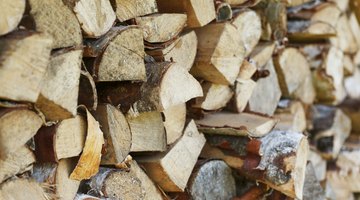Types of Wood to Burn in a Fireplace
Table of Contents
Different tree species will burn differently in your fireplace. Burning hardwood vs. softwood, or seasoned vs. unseasoned, will produce fires that vary in heat intensity, smoke production and the ambiance factor of snapping and crackling.

Remember that wood burns most efficiently with a moisture content under 20 percent.
Unseasoned Wood
Unless it has been dead for some time, when a tree is first cut down, it contains a lot of moisture. Fresh wood is called unseasoned. Moisture in unseasoned wood will make it more difficult to light and will cause the wood to smoke. If the flame goes out on unseasoned wood, the wood will continue to smolder. Smoldering wood adds an unpleasant burned smell to the house and creosote to chimney. To avoid this issue, your fireplace wood should be seasoned.
Seasoned Wood
Cut, split and stack wood outdoors to dry or "season." Drying occurs more quickly when the wood is stacked with every other row turned 90 degrees, which allows air to circulate better between the logs. Wood is best dried in a shed, away from rain. If you do not have a shed, cover the split wood with a tarp to keep rainfall off the wood. Avoid using tarps to cover split wood because they inhibit evaporation.
Appearance of Seasoned Wood
You can tell the wood is dry from the hollow sound that is made when you knock two pieces together. Seasoned wood is also cracked, gray in color and much lighter without the water content. Wood for a fireplace needs six months to one year to dry before using. Seasoned wood generates the most heat and burns clean, with less smoke than unseasoned wood. If you are buying seasoned wood, it will be sold by the cord or half cord. A cord measures 8 feet long, 4 feet high and 4 feet deep. Seasoned wood will cost more than unseasoned wood.
Hardwood Varieties
Deciduous trees like eucalyptus, madrone, oak and walnut as hardwoods are the best choice if you want to produce sustained heat. Ash, locust, hickory, apple, plum, cherry, pear and ash come next, putting off slightly less heat. Apple, pear, plum and cherry woods offer a fruity scent as they burn. Maple, sycamore and elm are fair for heat production, while cottonwood, alder and willow are poor choices for heat production. As seasoned wood, all hardwoods will burn longer than softwoods, giving off continuing heat and ambiance. Hardwoods tend to be more difficult to start burning. A small amount softwood, which is easier to light, and some clean newspaper make good kindling for starting a hardwood fire.
Softwood Options
Conifers are softwood with pine and fir suitable for burning. Fir gives off a delightful scent, reminiscent of the holiday season. Cedar gives off a pleasant scent, and it snaps and crackles as it burns. As seasoned wood, conifers burn hot but fast. If you want long-lasting fire, you will need to continue to add more wood. Seasoned fir can be used as kindling to get hardwoods to start burning.
The Drip Cap
- Different tree species will burn differently in your fireplace.
- If the flame goes out on unseasoned wood, the wood will continue to smolder.
- Cut, split and stack wood outdoors to dry or "season." Ash, locust, hickory, apple, plum, cherry, pear and ash come next, putting off slightly less heat.
- A small amount softwood, which is easier to light, and some clean newspaper make good kindling for starting a hardwood fire.
- Fir gives off a delightful scent, reminiscent of the holiday season.
- If you want long-lasting fire, you will need to continue to add more wood.
References
Writer Bio
Barbara Raskauskas's favorite pursuits are home improvement, landscape design, organic gardening and blogging. Her Internet writing appears on SASS Magazine, AT&T and various other websites. Raskauskas is active in the small business she and her husband have owned since 2000 and is a former MS Office instructor.
Photo Credits
- IvanMikhaylov/iStock/Getty Images
- IvanMikhaylov/iStock/Getty Images
More Articles



